-
Dyslexia Dissolved Book



Book Excerpts
Testimonials from Parents and Educators“I saw improvement quickly in just a couple of months in Dysolve®, like changes in his reading. We weren’t working on reading directly at the beginning of his Dysolve® program, but still he could see his mistakes and stop and correct them and read a little longer.”
– Mother of student with dyslexia and ADHD
“One of the great things is, Dr. Coral gets him. She’s not put off by his temper tantrums. He got an 85—in English. Before, he hated to write; he hated to read. I was correcting every other word he read. He’s actually quite articulate in his writing now. He hasn’t had any anger outburst or any meltdown since the beginning of 7th grade. He had been studying for tests alone since the last quarter in 6th grade. Definitely, he’s moving in the right direction.”
– Mother of student with dyslexia, autism, ADHD and ODD
“It’s hard to think of her as that little girl who was defeated when I first met her. But not now, not anymore. She’s going to go out and grab the world by storm.”
– Teacher of student with dyslexia and speech impairment
“He’s done relatively quickly. He very rarely has questions about homework. That’s one of the best things we’ve seen with Dysolve®, because it was such a struggle to get him to do his homework.”
– Father of student with dyslexia, ADHD and processing speed difficulties
“Her growth was fast in Dysolve®. After four months of Dysolve®, Bella’s speech cleared up and her stuttering dissipated. Before, even with my help, she got 60s and 70s in her spelling tests. Now she consistently gets 100s on spelling tests. Now she thinks she’s great at spelling and wants to spell. There’s a new confidence about her. Bella went up three reading levels within four months of Dysolve®. Bella didn’t read before. Now she’s more apt to read. With the AIS at school, the improvement was slow. But since Bella started Dysolve®, she skyrocketed.”
– Mother of student with ADHD, dyslexia and speech impairment
“Buster was never diagnosed with a learning disability. Until he used Dysolve®, he showed slow progress but not enough to reach grade level. Buster was reading at grade-level expectations less than half a year after starting the Dysolve® Program. Not only was he a reader, he was a motivated learner on the path for scholastic success…Given the relatively low cost of Dysolve® as well as the short amount of time one needs to dedicate each day to the method, school administrators should consider using such a program to complement traditional reading instruction. Dysolve’s targeted activities can benefit learners on the margins and pull them into grade-level performance in a precise and efficient way”
– College Professor and father of student with dyslexia
“Dr. Coral said, ‘I can fix this problem.’ That gave me and my wife the confidence we were needing in a program to help our son. They’re great coaches. They encourage and really want to see their students succeed. While their students succeed, it brings them pleasure and joy. I would love to see parents do that for their children academically because I think the tools that you’ll give them in a program like Dysolve® will really help them way beyond high school…It’s going to help them with their future.”
– Father of student with dyslexia and auditory processing deficits
Table of Contents

With endnotes on what the research says on many related topics
-
Myths and Facts

Children outgrow reading problems
If the reading problem is due to dyslexia, it will often not magically disappear without appropriate intensive intervention. Dyslexia is different from a developmental lag in reading (delayed reading). With dyslexia, a delay in intervention may make it even harder to catch up to grade-level reading. Consider these figures: the typical student in elementary school learns about 3,000 new words a year, increasing to about 10,000 by Grade 5.1 Shaywitz, S. (2003). Overcoming dyslexia. New York: Alfred A. Knopf.
You can/cannot cure dyslexia
Dyslexia is not a disease that has to be “cured.” Dyslexia is a developmental problem and is often referred to as “developmental dyslexia.” The brains of individuals with dyslexia process language differently. To make sense of a page of text, readers have to be able to process words rapidly and automatically. Those who cannot do so are considered to have a reading or learning disability. Left untreated, dyslexia usually remains a lifelong condition. However, based on state-of-the-art knowledge on the plasticity of the brain and neurological functioning, the Coral Method® focuses on correcting the processing problems underlying dyslexia.
See Coral Method® >
Individuals with dyslexia see letters backwards
Contrary to popular belief, people with dyslexia do not see mirror images of letters. Dyslexia is not a visual-processing problem. However, Dysolve® consultants have observed that some individuals with dyslexia do indeed confuse b and d regularly. Such individuals may also confuse other letters of the alphabet. This is because these individuals can’t make firm connections between letters and sounds. Individuals with dyslexia lack phonemic awareness, i.e., sensitivity to the sounds of words.
Dyslexia affects only boys
Dyslexia affects both sexes equally. A large-scale longitudinal study on dyslexia found no significant gender difference in the population affected.2 Study by the Yale Center for Dyslexia and Creativity of 445 children in public schools in Connecticut from 1983-4. (Moreover in some families, dyslexia affects many members while in other families, only one person is affected.)
You can easily tell if somebody has dyslexia
Dyslexia is not a single, unitary condition. It appears in many forms along a continuum. Also, many people with dyslexia do not themselves realize they have this disorder. The disorder can only be evaluated through special testing.
Go to Dysolve® Dyslexia Test >
A person with dyslexia may be articulate, even eloquent, in speech. Many are highly intelligent and capable while others have special talents. A person with dyslexia can mask the disability by working especially hard to attain satisfactory scores in reading.
People with dyslexia also have ADHD
Dyslexia and ADHD are known as co-existing conditions in research.3 Germanó, E., Gagliano, A., & Curatolo, P.(2010). Comorbidity of ADHD and dyslexia. Developmental Neuropsychology, 35(5) 475-493. At Dysolve®, our consultants can predict when ADHD symptoms such as restlessness may appear during screening and training. At the same time, Dysolve® consultants note that people with dyslexia may appear to have attention deficits because they can’t always follow instructions or remember what was said. Because they have problems processing language, they may attend fully to the speaker yet still fail to understand and store the message. Some of Dysolve® tests are designed to assess the effects of certain language tasks on attention and hyperactivity. Research on the link between dyslexia and ADHD is ongoing and shared more extensively with Dysolve® members.
See Dysolve® Program >
Individuals with dyslexia have poor handwriting because of weak motor coordination
As with the rest of the population, some individuals with dyslexia have poor handwriting. Dysolve® consultants find that in some cases, individuals with dyslexia write illegibly because the letters and words do not carry stable, secure meanings as they do for the typical population. In others, students may try to hide their uncertainty over spelling by writing illegibly. Dysolve® researchers are presently studying the relationship between motor coordination and characteristic symptoms of dyslexia. Research on this and related topics is ongoing and shared more extensively with Dysolve® members.
-
Dysolve® Research Studies

DYSOLVE® STUDY RESULTS
All from School-Administered State/Standardized Reading Tests
CLINICAL TRIAL 2022-2025
Evaluated independently by The Center for Research in Education & Social Policy, University of Delaware
Ongoing recruitment, target n = 400 9 states in 20241 Dysolve® groups showed higher score gains than controls after 1-4 months across grades 3-8, race, economic status2
1 New York, New Jersey, Mississippi, Illinois, Ohio, Kansas, Wisconsin, Louisiana, North Carolina
2 These preliminary results were from schools where all Dysolve® users started below 35% and had at least 2 hr of Dysolve® training.
ARIZONA PILOT 2020
Dysolve® users improved in learning, reading, and/or math within 4 months
NEW YORK AND PENNSYLVANIA PILOTS 2013-2019
Dysolve® users advanced from below 25% to above 50% within 1.5 years; achieved Honors more than controls. Permanent gains
CASE STUDIES 2018
Book - Dyslexia Dissolved: Successful Cases of Learning Disabilities, ADHD and Language Disorders 70% started below 25% in grade 4+. All advanced to the top 20% or had grades in the 90s in high school
Dysolve® training continues until language processes reach 90-100% efficiency:


CONTROL STUDY
The effect of the Coral Method® on segmentation, single-word reading, and processing speed
BACKGROUND
This control study compared intervention effects of the Coral Method® to the Orton-Gillingham-based Wilson Reading System®.Training and study period: March-June, 2014 Training sessions: 45 mins., once a week in an afterschool program Site: Van Wyck Junior High School, Wappingers Falls, NY Participants in program: 26 sixth and seventh graders Participants in study: 18 sixth and seventh graders4 Only regular attendees were included in the control study. Participant's proficiency level: Level 1 or Level 2 on the New York State’s English Language Arts (ELA) test in Grade 4 or 5 (Level 3 = Meets Proficiency Standard; Level 1 = Well Below Proficiency) Design standards: The study design followed the recommended criteria of the Institute of Education Sciences (2013) and the National Reading Panel (2000) for efficacy research, as well as recommended guidelines for fidelity of implementation, procedural reliability, and inter-rater reliability. The study was approved by the Institutional Review Board of Marist College and the Wappingers Central School District, NY. Control group: The class was taught by an experienced school teacher with Wilson Level 1 certification. The class followed the Wilson Reading System®, which teaches encoding and decoding skills. With this method, students tap out the sounds of words in learning segmentation. Coral group: The class was taught by an experienced instructor trained in the Coral Method®. Based on this method, a detailed linguistic-cognitive profile of each student was created initially. Each student then received weekly packets tailored to his or her particular problems with language. The student's weekly packets did not include segmentation exercises. This was to see if transfer effects occurred. RESULTS
Segmentation test
The ability to segment words into single sounds is crucial to spelling and word recognition in English. Although teachers tend not to focus on this skill beyond primary grades, Dysolve® consultants recognize that older students in remediation often continue to struggle with it throughout school. This is apparent in this control study: both groups of participants in middle school performed under the passing rate of 50% in the segmentation pre-test.5 Pre-test = test given before training starts; post-test = test given after training ends. But after 3 months of training in the Coral Method®, the Coral Group reached an accuracy rate of 76% on average while the Control Group declined slightly. This was even more significant considering that the Coral Group did not practice with segmentation directly in its weekly drills. Points were allocated in the following manner:
0—The test word was uttered as a single unit; the student uttered the wrong sound; the sound was in the wrong position in the word; the student said the letter instead of the sound (e.g., “double U” W instead of /w/ sound); or the student abandoned the attempt to segment the word.
1—A single phoneme or phoneme cluster was given in the right position in the word.
Segmentation accuracy rate = (Student’s total points for all test words ÷ total number of segments of all test words) x 100

Single-word reading
Fluent reading requires recognizing words swiftly and effortlessly so that we can decipher sentences while holding on to their meanings mentally. Dysolve® consultants recognize that students in middle school have to read at 200 words per minute (wpm) or faster on average to reach this goal. None of the study participants was able to read common single words at this rate during the pre-test, which partly explains why they were in remediation. But after 3 months of training in the Coral Method®, the Coral Group reached an accuracy rate of 44% on average in single-word reading at 200 wpm, compared to the Control Group’s average of 31%. More importantly, 56% of the students in the Coral Group scored above 50%, compared to only 11% in the Control Group.

STATISTICAL SIGNIFICANCE
A series of chi-squared tests revealed no significant differences between the Coral and Control Groups in terms of gender, minority status, participation in speech/language therapy, grade level, and two-/single-parent household.
A series of analyses of covariance (ANCOVAs) were run to examine the effect of the intervention on segmentation skill. Both ELA and segmentation pre-test scores were entered as covariates. Table 1 shows unadjusted and adjusted means for these analyses. The ANCOVA for the segmentation test revealed a significant effect of the intervention, F(1, 12) = 15.11, p = .002, η2 = .557, with students in the Coral Group performing better (see Table 2).This transfer effect was important, considering that training was only for 3 months.
Table 1. Descriptive statistics of unadjusted and adjusted means of segmentation post-test by group
Unadjusted means Group Mean Std. Deviation N Control 23.2857 10.67262 7 Coral 45.3333 7.08872 9 Total 35.6875 14.14081 16 Adjusted means Mean Std. Error 95% Confidence Interval Lower Bound Upper Bound 23.667a 3.766 15.461 31.873 45.037a 3.226 38.008 52.065 a. Covariates appearing in the model are evaluated at the following values:
ELA Grade 4 score = 626.88, segmentation pre-test score = 26.2500.Table 2. Segmentation post-test: Tests of between-subjects effects
Source Type iii Sum of Squares df Mean Square Corrected Model 2112.652b 3 704.217 Intercept .778 1 .778 ELA Grade 4 17.658 1 17.658 Segmentation Pre-test 165.954 1 165.954 Group 1116.269 1 1116.269 Error 886.785 12 73.899 Total 23377.000 16 Corrected Total 2999.438 15 f Sig. Partial Eta Squared Observed Powerc 9.529 .002 .704 .977 .011 .920 .001 .051 .239 .634 .020 .074 2.246 .160 .158 .281 15.105 .002 .557 .945 b. R Squared = .704 (Adjusted R Squared = .630)
c. Computed using alpha = .05 -
Dysolve® Case Studies

The charts below cover different aspects, based on problems specific to the individuals studied.
Students’ names have been changed for privacy reasons.CASE STUDY: OLIVIA, GRADE 4-6


CASE STUDY: GEORGE, GRADE 2-3
George’s grade-level reading was not fluent before joining Dysolve®. Initially, he could only read at most 11 words accurately before stumbling. He could only read at most 39 words, with many errors, before his reading broke down completely, measured by 3 misreadings in a row. After 16 months in Dysolve®, he could read more than 600 words without such breakdowns, and as many as 71 words consecutively without errors. Test words were taken from frequency lists of common words; the longer lists included less common words such as commission. In his second year at Dysolve®, his school report showed his reading had improved to above-grade level.


Note: Fluency breakdown is defined here as 3 consecutive misreadings. George read all the words in Tests 2 and 3 without fluency breakdown.
CASE STUDY: SARA, GRADE 2; ROBYN, GRADE 5; DAISY, GRADE 10

CASE STUDY: CAITLYN, NY, GRADE 5

CASE STUDY: WAYNE, NY, GRADE 6

CASE STUDY: BEN, NY, GRADE 6

-
Dysolve® Case Stories

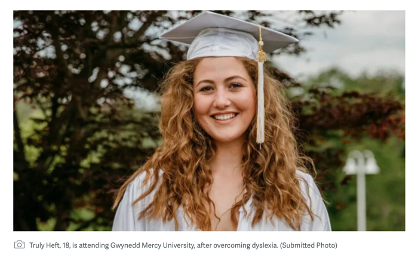
Truly Heft, PA, used Dysolve® in 7th grade
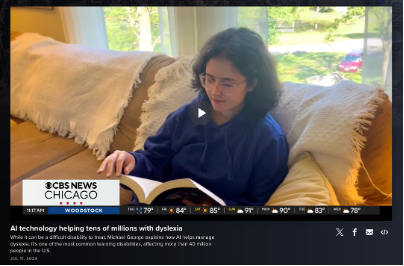
Meghan Odell, NY, used Dysolve® in 5th grade

Calvin Martin, NY, used Dysolve® in 4th grade
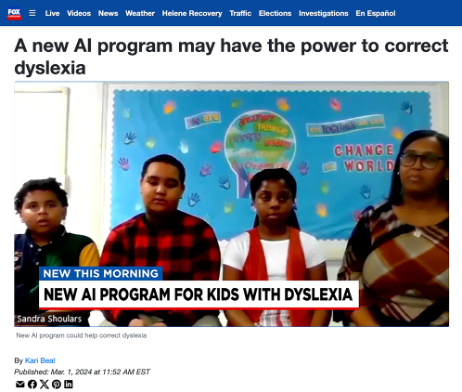
Felton Hedgepeth, Jesseme Lynch, Blessin Daniels,
NC, used Dysolve® in 3rd grade
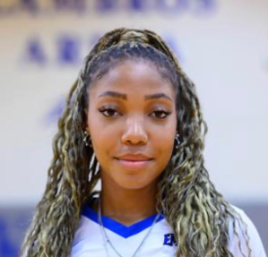
Aaliyah Williams, NY, used Dysolve® in 5th grade
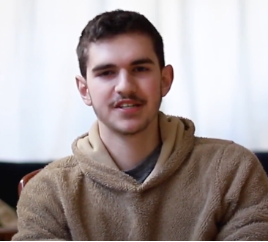
Philip Lamberton, NY, used Dysolve® in 5th grade
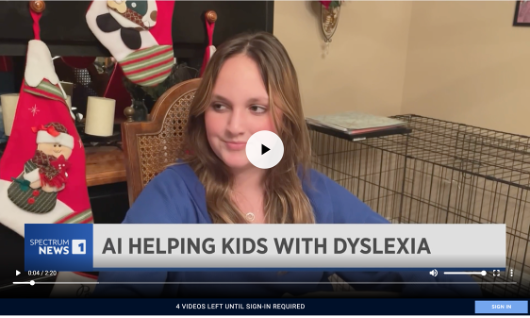
Caitlyn Coyle, NY, used Dysolve® in 3rd grade
Sarita Hernandez, MA, used Dysolve® in 10th grade

For more stories, see Dyslexia Dissolved book>
Libby, Grade 4 Billy, Grade 7 Claire, Grade 5
Students' names have been changed to protect their privacy
LIBBY
Joined Dysolve® in Grade 4
In her Mom’s words…
As I write this, my daughter, Libby, is taking AP Bio, Honors English, and Honors Geometry as a high school freshman. She has a 98+ GPA. She loves school and is quite chatty. So why am I writing this post for Dysolve® ? Well, Libby wasn’t always this way.
In Kindergarten, Libby mostly stared at the speaker and didn’t respond. When she did, it was garbled. Only after being in the pilot program of Dysolve® did I understand that Libby was having so much trouble processing language that she was overwhelmed.
Even though she repeated 1st Grade, Libby still failed to meet standards. No matter how much we put into homework, Libby still struggled. After paying $5,000 out of pocket, a neuro-psych test determined that Libby had dyslexia.
When she couldn’t get the support she needed at school, Libby attended a summer program at a private school specializing in dyslexia. This school used the Orton Gillingham method. However, Libby was still reading well below grade level after the second summer there.
In 4th Grade, Libby needed even more help in reading and writing. She was sad that she made so many mistakes. She was cranky. She had headaches. She was not a happy girl.
Through a colleague, I found Dr. Coral. Her initial screening showed that Libby had dyslexia, but Dr. Coral wanted to probe deeper to get to the root cause. Root cause? Wow, no one ever said that they could get to the root cause of Libby’s problems!
What Dr. Coral found was astounding. She helped me link Libby’s difficulties to underlying causes. I now understood why Libby spoke the way she did. I now understood how much her mind was pre-occupied with processing the language around her.
We signed up for what was later to become the Dysolve® Program. I asked Libby’s school for support in the areas that Dr. Coral suggested, but they would only act on standardized evaluations. I pushed the school to run their standardized evaluation. Lo and behold – their CTOPP results agreed with the phonological processing part of Dr. Coral’s evaluation. Still, the school could not offer appropriate intervention.
Dr. Coral taught me how to help Libby. Within 3 months of the Coral Method®, Libby stopped having headaches. Within 6 months, Libby’s speech started to clear up. Within 9 months, Libby’s teachers noticed the dramatic change in her schoolwork. Libby received the President’s Honor Award for Most Improved in 5th Grade.
By the middle of 6th Grade, Libby was reading at grade level and excelling in all subjects. She was declassified from Special Education at the end of 6th Grade. She devoured books during that summer.
Seventh Grade was a year of amazing transition. Libby was placed in Honors Math and English. She was on the High Honor roll every semester (overall average 95+ out of 100). Her classmates now saw Libby as a role model and a leader. She was being sought after as a project partner. Her friends were calling her to see what answers she got on her homework. She was no longer the lost child of yesteryear.
I am convinced that without the intervention of Dr. Coral and the Coral Method®, Libby would still be struggling. She would still be having headaches. She would be angry and frustrated. She would have shut down and not engaged with the world around her. She would still be effectively mute.
As I write this, Libby is working above grade level in all of her classes in high school. Her future is bright. I see nothing that will stand in her way. She is confident. She is articulate. She is full of life. She is meeting her potential. She is finally herself.
Billy
Joined Dysolve® in Grade 7
In his Mom’s words…
5 months into Dysolve®
As a mother, I’ve suffered alongside my 12-year-old son, who has struggled in school since the early grades, falling two grades behind in reading. Billy used to come home from school with a headache most days. When our pediatrician told us about Dysolve®, we jumped right in.
The one thing I’ve noticed with Billy already is he now feels there’s hope…His head used to be down when he got off the bus, defeated. His head is not down when he gets off the bus these days. He now believes he’s smart and will learn how his brain needs to learn. All of us in the family are very excited about our new journey…Stay tuned!
8 months into Dysolve®
Billy is thriving at school, and I know it’s largely due to this program. He rarely complains of headaches anymore. He has an 86% overall average this quarter. Before, he was struggling so much it wouldn’t have made a difference to his score if he’d just put his name on the test and left instead of trying to fill in the answers.
He’s keeping his grades up while also getting into sports, band and theater. Our family can see that, finally, Billy is beginning to take off and take charge of his future. He’s very optimistic now and believes in himself.
Dysolve® is so different from any other program. They work with Billy and for Billy. It is so individualized that they can focus on his strengths while dealing with his “weak” spots. Dysolve® is setting Billy free so he can make his own way, and we are all looking forward to what’s in store.
12 months into Dysolve®
Billy’s world has opened up. We’ve been somewhat inconsistent at home with his practice, but we’ve put our best efforts forward given the business of our lives.
Billy left 7th grade with several awards. The most important was Most Improved Student. As a mother present at the ceremony, I was so happy for him, and the look on his face was so great to see.
In his first 2 weeks of 8th Grade, he got the top score in an essay he worked on independently and 100% in spelling for the first time.
To me as a parent, Dysolve® is a miracle worker. It does re-train and help Billy create the correct ways to read. He is much more confident and now believes he can succeed.
I can’t wait for the future. It is wide open for Billy.
Claire
Joined Dysolve® in Grade 5
In her Dad’s words…
Throughout elementary school, my daughter, Claire, had to struggle with the challenges caused by her premature birth. She received 1s and 2s in all of her classes on a 4-point system. She qualified for multiple services at school but lost them one by one, even though she was not improving.
Homework was a 2- to 3-hour ordeal for us all. We shuddered to think how many more hours we would need to spend to help her at home when she got to middle school.
I had started to accept that Claire was barely going to get by in life. I felt that if my wife and I could keep Claire from dropping out of school, and if she got her high school diploma, we would be winners in my book.
When I worked as a school resource officer, I saw good, bright children like Claire dropping out of school. A few years later, I ended up arresting some of them. The system failed them. That’s the future that I hoped to avoid for my Claire.
After some searching, we found Dysolve®. Over the next year for usually 5 nights a week, my wife or I continued to struggle through several hours of homework with Claire, followed by Dysolve® training.
My wife and I knew that we were going to have to make sacrifices to make this work but that’s what any parent would do for their kids. The idea that we could give Claire a fighting chance in the world was all the inspiration we needed.
We started seeing improvement several months into Dysolve® at the end of 5th Grade. A year went by and Claire exceeded our expectations. Her first quarter’s report card in 6th Grade was a shocker for us. She made the honor roll, which requires a GPA of 90+. We never thought Claire could achieve such high grades. When Claire continued to remain on the honor roll for the second and third quarters, we knew that this was for real.
Now that Claire is doing homework independently and plans to go to college, I look back and can now say it was worth every long night, all the sacrifices and every battle we had with Claire. This experience has given Claire confidence in her ability to overcome any obstacle.
My advice for parents is to never take no for an answer. If one door closes on you, kick open another! If you feel something is not right with your child, keep on fighting until you get the answers you need and the services your child requires to give them a chance for greatness.
I am just happy that we found Dr. Coral and Dysolve®. Now Claire will no longer be limited by her ability, but only by her motivation. I don’t think a parent could ask for anything more.
-
Where Are They Now?
 Students' names have been changed to protect their privacy
Students' names have been changed to protect their privacyThese students all failed standardized reading tests at school before joining Dysolve®
Liam
Joined Dysolve® in Grade 7-8
Honor roll in Grade 7+
*Most Improved Student Award* from school
Linsey
Joined Dysolve® in Grade 4-6
Honor roll in Grade 6+
*Most Improved Student Award* from school
Cindy
Joined Dysolve® in Grade 5-7
Honor roll in Grade 6+
*Most Improved Student Award* from school
Mark
Joined Dysolve® in Grade 4-5
Honor roll in Grade 5+

